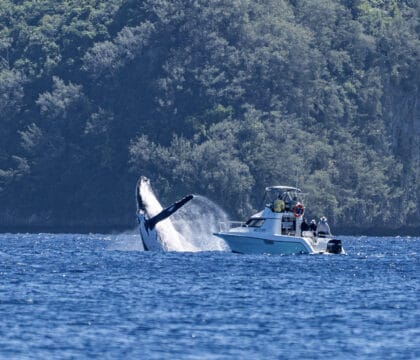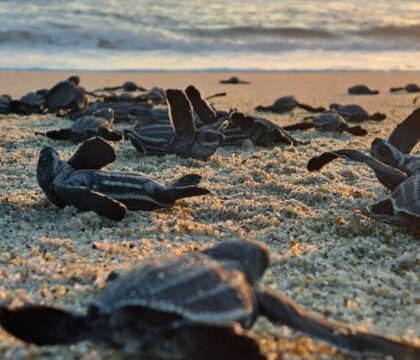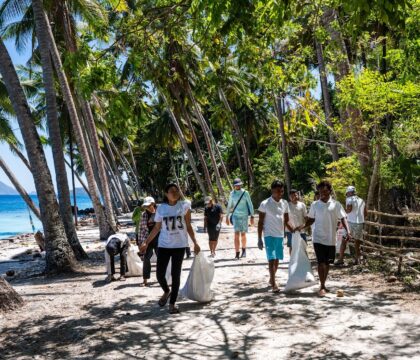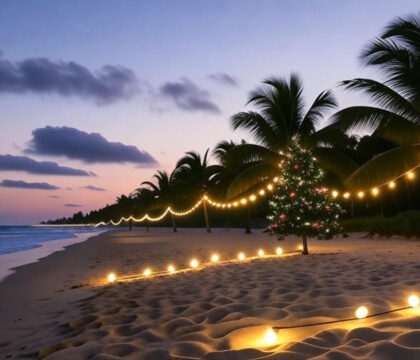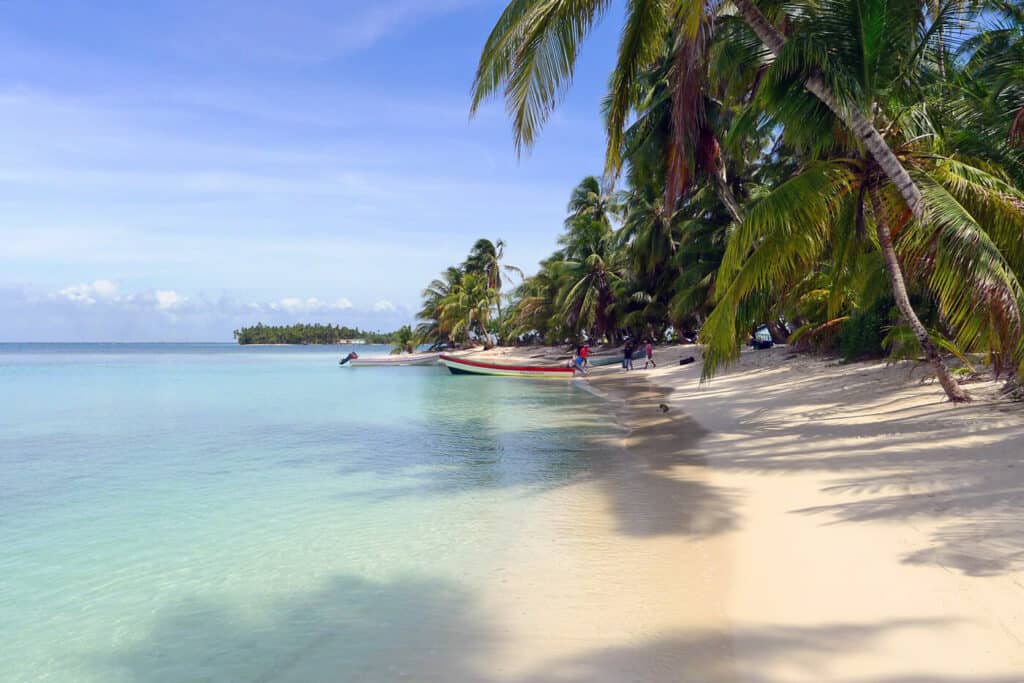August 1, 2025 • Travel Ideas
One of the Caribbean’s Best-Kept Secrets
Nestled in a quiet corner of the Caribbean Sea off the coast of Nicaragua, Little Corn Island is a rare gem that has largely escaped the rapid development seen in neighboring destinations. Unlike many other Caribbean hotspots that are dotted with sprawling resorts, this small island, home to roughly 1,000 residents, remains largely untouched, offering visitors an authentic experience of natural beauty and local culture.
For travelers seeking a glimpse of the Caribbean as it was a century ago, Little Corn Island offers an immersive, low-impact ecotourism experience rooted in cultural authenticity and natural beauty. We don’t make these claims lightly. We’ve been leading eco-tours throughout the Caribbean for decades, and have seen it all. We chose Little Corn as the focus of our Nicaragua Snorkel & Volcano Expedition because we believe it offers one of the most accessible and relaxed snorkeling experiences in the Caribbean—perfect for travelers who appreciate easy water entry, calm conditions, and the chance to spot rays, turtles, or other special marine life without the crowds.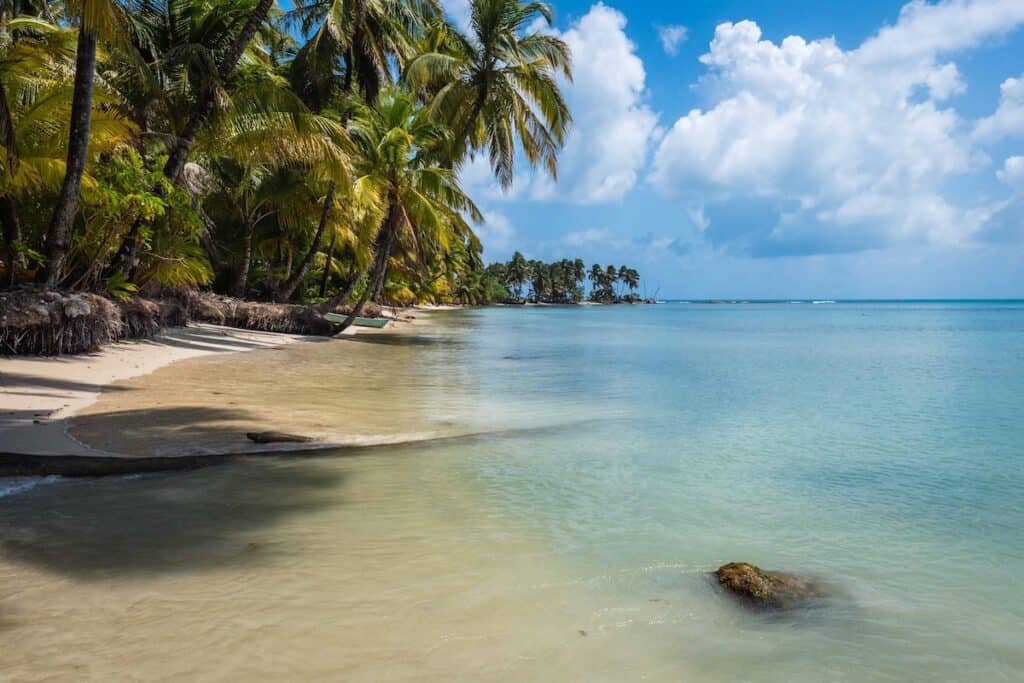
In this guide, we’ll cover everything you need to know to prepare for your visit to this Caribbean hidden treasure.
- Where is Little Corn Island?
- How to Get to Little Corn Island
- Is It Safe to Visit Little Corn Island?
- Best Time to Visit Little Corn Island
- What is Little Corn Known For?
- Beaches on Little Corn Island
- Where to Stay on Little Corn Island
- What to Do on Little Corn Island
- Snorkeling and Reef Conditions
- Marine Life and Animals You Might See
- Is Little Corn Island Worth Visiting?
Where is Little Corn Island?
Little Corn Island is a tiny island (just 1.5 square miles) located 50 miles off the eastern coast of mainland Nicaragua, in the heart of Central America. It lies just 8 miles north of its larger sister, Big Corn Island, which is home to a small domestic airport that serves as the main gateway to the area.
The isolation of Little Corn Island is a rarity for a tropical paradise in the Caribbean. With no cars and few signs of modern development, Little Corn Island’s remoteness is part of its charm. The island offers a rare sense of seclusion, surrounded by palm-lined beaches, turquoise waters, and easily accessible coral and seagrass habitats, making it an idyllic setting for nature lovers and adventure seekers alike.

How to Get to Little Corn Island
Getting to Little Corn Island may take some effort, but it’s a journey well worth the adventure.
With a bit of research and planning, you can make the trip on your own. Or, for a more seamless experience, join Oceanic Society’s Nicaragua Snorkel & Volcano Adventure, which includes visits to both Little Corn Island and the historic city of Granada. We take care of the travel logistics so you can focus on snorkeling vibrant coral reefs, exploring cloud forests, and experiencing Nicaragua’s natural and cultural wonders.
Step 1: Fly to Managua, Nicaragua
For international travelers, the first step is flying into Managua, the capital of Nicaragua. You can find flights to Augusto Cesar Sandino International Airport (MGA) from many major U.S. airports.
Step 2: Domestic Flight to Big Corn Island
From Managua, you’ll book a domestic flight to Big Corn Island, with daily service operated by La Costeňa Airlines. The flight from Managua to Big Corn Island is quick, often in a small propeller plane, and takes about an hour and twenty minutes.
Pro tip: La Costeña has strict luggage policies. If you want to avoid paying baggage fees, check their weight limits and pack light.
Step 3: Take the Panga from Big Corn to Little Corn
Once you arrive in Big Corn Island, the adventure continues. A short taxi from the airport to the wharf (typically just a few USD) brings you to the next leg of your journey—a 30-minute ride on a public panga, a small open-air boat, that carries passengers across turquoise waters to Little Corn Island. Keep in mind, if the weather is rough, your panga might be delayed.
Pro tip: There are no ATMs on Little Corn Island, so be sure to bring enough cash (USD) to serve you throughout the trip. Though most accommodations will accept credit cards, many businesses on Little Corn Island accept cash only, typically both USD and Nicaraguan Córdobas in cash.
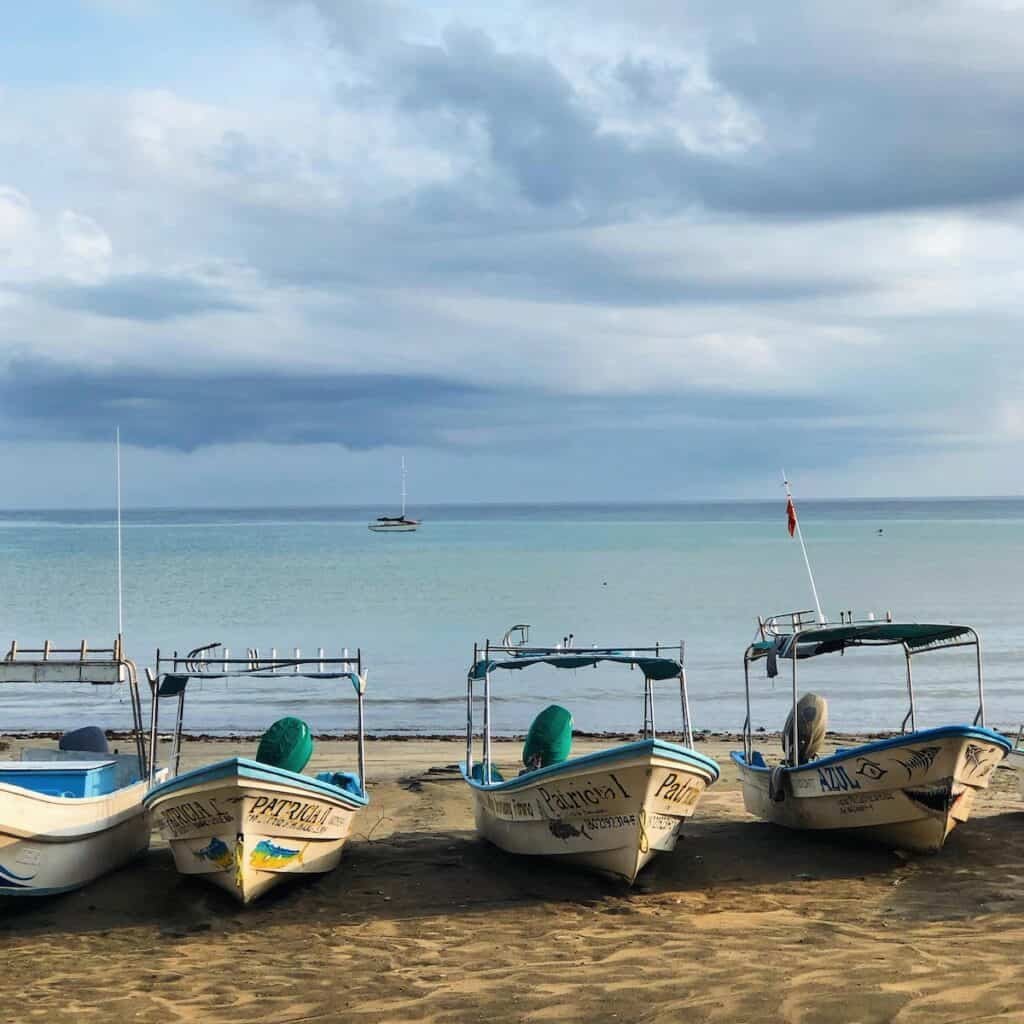
Panga boats rest on the shore of Little Corn Island, where tranquil Caribbean waters set the scene for daily snorkeling and marine adventures. © Stephanie Crephead
What to Expect on the Panga
The boat ride is often part of the adventure. You might get wet, so protect valuables (dry bags are ideal), and consider wearing a rain jacket or poncho.
- Avoid the sides if you don’t want to get splashed.
- The back of the boat is typically less bumpy; the front gets less splash, but more impact from the waves.
- Boats can get crowded with locals, tourists, and cargo, so arrive early if you want a seat choice.
- Hold on to your hat—and enjoy the ride to paradise.
Is It Safe to Visit Little Corn Island?
Yes—Little Corn Island is safe to visit. As a remote, off-the-beaten-path destination, it sees fewer tourists than mainland hotspots and has no busy nightlife districts or crowded markets, places where petty crime can sometimes occur. The island is a tight-knit community that deeply values tourism, and there’s a strong sense of hospitality and care for visitors. With a laid-back pace and few crowds, Little Corn Island remains a peaceful and welcoming place.
“Many guests arrive in Nicaragua with doubts shaped by headlines or secondhand warnings,” says Ernesto Ocampo, an Oceanic Society naturalist from Nicaragua. “But by the end of their trip, they’re struck by how safe they feel, how welcoming everyone is, and how untouched the natural beauty is.”
As with anywhere, it’s still important to take common-sense precautions: secure your valuables, avoid walking alone at night in unlit areas, and travel with a buddy when possible.
Best Time to Visit Little Corn Island
If you’re planning your trip, the best time to visit is during the dry season, from mid-November to mid-May, when the skies are blue and the sea is calm. These conditions are perfect for underwater adventures and long beach days. Be sure to avoid hurricane season, which peaks from August through September.
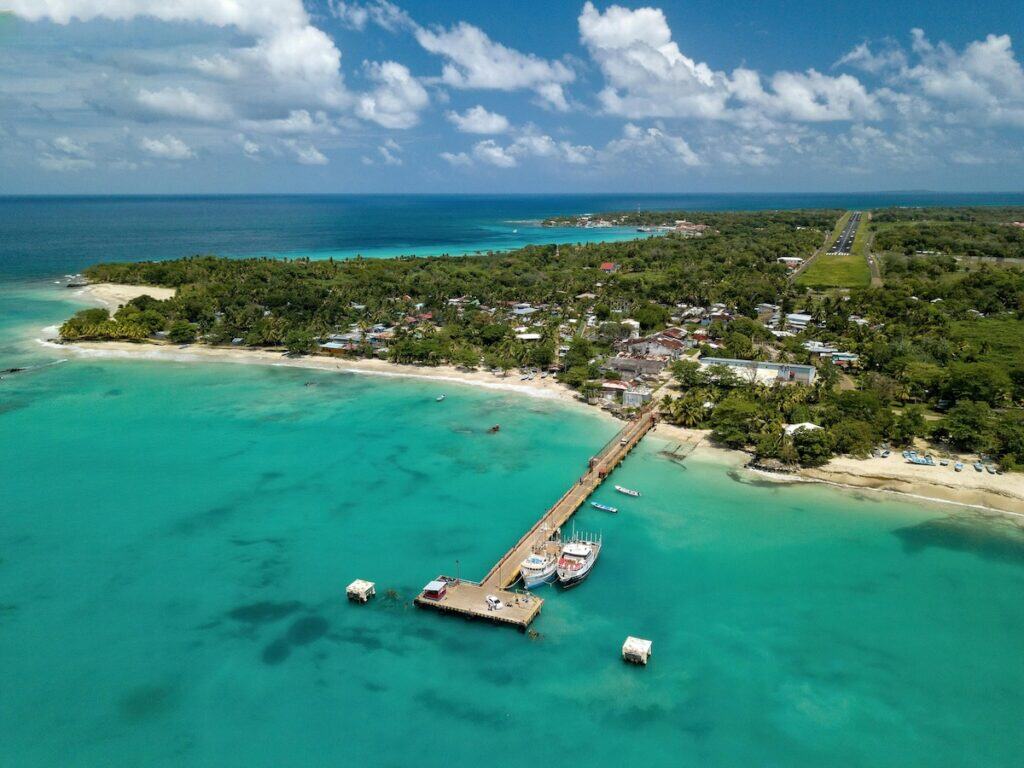
An aerial look at Little Corn Island, Nicaragua, featuring a docking port and small air landing strip, your gateways to a remote Caribbean paradise rich in natural beauty and marine life. © Roberto Zuniga
What is Little Corn Known For?
Little Corn Island is renowned for its laid-back island living, landscapes, thriving marine ecosystems, and welcoming people eager to share their heritage with visitors.
A Car-Free, Barefoot Paradise
With no cars, the island is blissfully free of traffic and honking horns. The preferred mode of transportation? Barefoot.
Soft dirt paths weave through coconut groves and shaded jungle trails, leading to turquoise shores and peaceful beaches. You’ll find hammocks strung between trees, perfect for an afternoon nap or reading session by the sea.
Exceptional Snorkeling and Healthy Marine Life
The marine ecosystems surrounding Little Corn Island remain relatively healthy compared to many other parts of the Caribbean. Thanks to its seagrass beds and coastal mangroves, the island supports a variety of marine life, from rays and octopus to the occasional sea turtle. Seagrasses are fundamental for marine ecosystems as they regulate water and support growth of nearby coral reefs, but unfortunately, they are one of the first casualties of coastal development. Snorkeling here is ideal for those seeking a calm, easygoing experience—great for families, older travelers, or anyone looking to enjoy a few relaxed hours each day in the water.
Oceanic Society travelers have the opportunity to experience these thriving underwater habitats firsthand as part of our Nicaragua Snorkel & Volcano Adventure, while also learning about the ecological importance of these fragile yet resilient marine environments.
Peace, Space, and Seclusion
With a local population of just 1,000, and only around 300 tourists visiting at any given time, you might just have one of its many world-class beaches all to yourself. Perhaps the quintessential Little Corn Island experience is lying on a soft white sand beach, listening to the tide, and enjoying the water lapping at your feet–maybe with a good book and cocktail in hand.
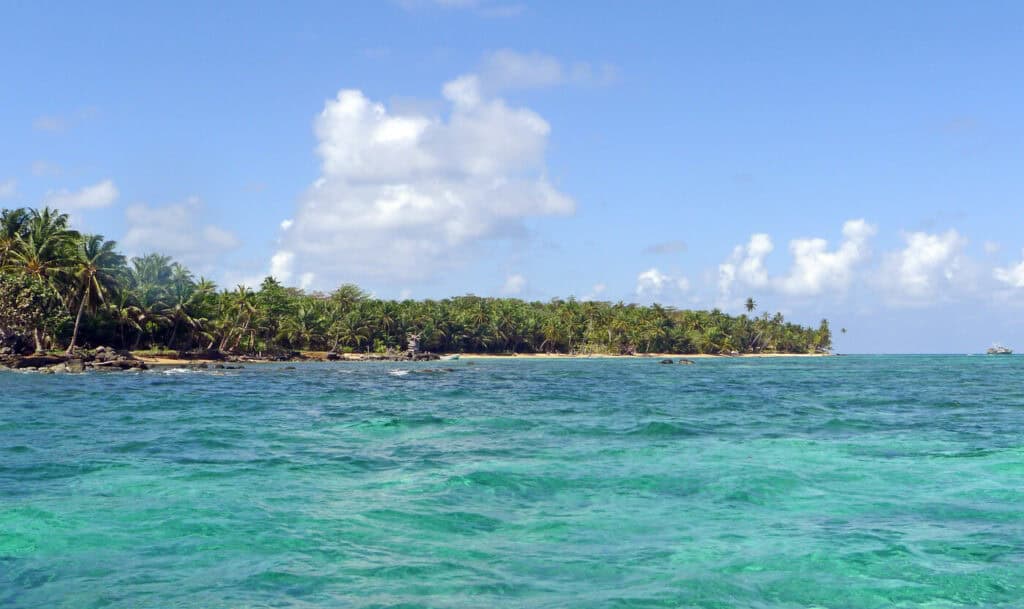
Blue waters of Little Corn Island.
Culture and Warm Hospitality
As throughout much of Nicaragua, and especially in small communities like Little Corn Island, the people are eager to share their cultural heritage.
“I love being able to connect travelers with the natural wonders, rich culture, and heartfelt warmth of the Nicaraguan people,” says Oceanic Society naturalist and Nicaraguan native, Ernesto Ocampo.
Little Corn Island has a unique cultural heritage compared to the rest of Nicaragua. It was a British colony until the early 1970s and has strong Afro-Caribbean and Miskito heritage, making it feel more culturally similar to other Caribbean island nations than to the mainland. As a result, English is widely spoken, making it easy for those less linguistically proficient to strike up a conversation with locals.
Food is often a great entry point for experiencing culture, and on Little Corn Island, many restaurants are run by local families. Pull up a chair, crack open a cerveza, and enjoy traditional dishes like gallo pinto con coco, a coconut-infused version of Nicaragua’s classic rice and beans, alongside freshly caught seafood.
Beaches on Little Corn Island
You can’t make a wrong choice when looking for a beach on Little Corn Island. But if you want to rotate venues, well, you’re only a quick trek away from another world-class beach. Welcome to Little Corn Island. Here is a list of some of the top choices:
Otto Beach
Possibly the nicest beach on the island (also the most popular), offering a quintessential Caribbean escape with coral reefs just offshore. Located on the island’s north coast, it’s the local beach for guests staying at Yemaya Reefs. A nearby restaurant makes it easy to spend the whole day here—mojitos, anyone?
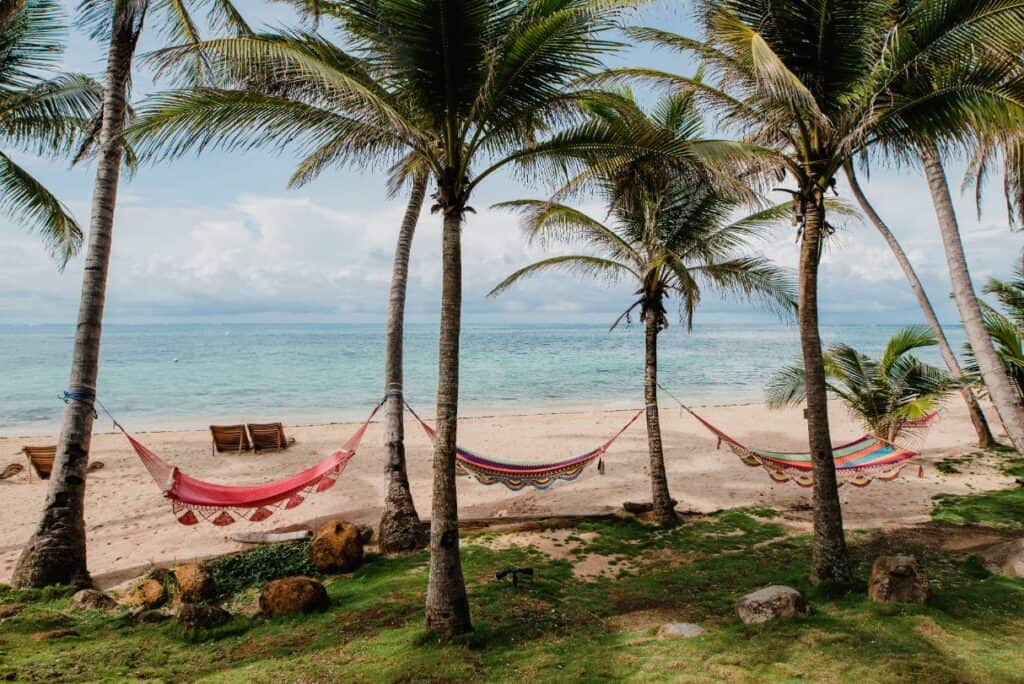
Hammocks by the beach at Yemaya Reefs on Little Corn Island. © Yemaya Reefs
Pelican Beach
This is the beach at which you’ll first arrive by panga—and it doesn’t disappoint. Dive shops, restaurants, and bars line the coast, making it perfect for those looking for a lively atmosphere–or even a game of volleyball. Located on the west side of the island, it’s a great choice for enjoying the sunset and is also the main departure point for boat excursions to nearby reefs.
Kelly Gully Beach
Located on the east coast of the island, this secluded and rugged beach offers dramatic scenes of crashing surf, driftwood strewn shores, and lush jungle backdrops – perfect for nature photography. You’ll likely be the only ones here, and if you’re an early riser, it offers a great spot to enjoy the sunrise.
Cocal Beach
A great alternative to Otto Beach, Cocal stretches along the northwestern coast with a more rugged, off-the-beaten-path feel. It’s excellent for snorkeling, less crowded, and just as beautiful—plus, it’s a prime sunset spot. Some lucky visitors have even spotted hawksbill sea turtles nesting here at night.
Long Beach
Just south of Otto Beach on the eastern coast of the island lies a long curve of wild, undeveloped coastline with beautiful white sand. This is a popular spot for sunrise views, long walks along the beach, or snorkeling at a variety of coral reefs that lie offshore.
Where to Stay on Little Corn Island
Little Corn Island, despite its small size, has an array of accommodations that cater to a range of travelers, from intrepid backpackers to ecolodge lovers and those seeking luxury, boutique hotels. As a result, the island has a sort of backpacker-meets-eco-luxury tourism culture, with travelers coming from all backgrounds.
If you’re seeking a budget option, you can easily find budget hostels and cabins for $10–$40 per night; smaller mid-range hotels and eco-lodges will typically range from $50–$100 per night; and high-end resorts run over $100 per night.
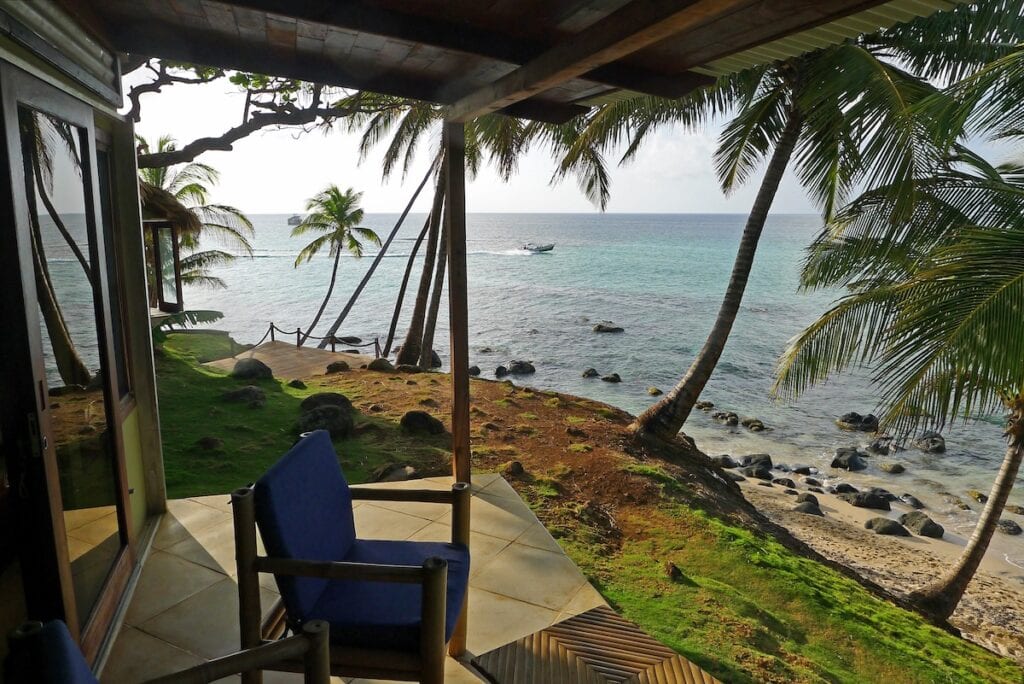
Hotel patio view overlooking beachfront of Little Corn Island
Here is a general breakdown according to pricing category, style, and what to expect for food and excursions offered through the lodging:
Budget Hostels & Cabins
Grace’s Cool Spot ($15 – $25 per night): Budget private bungalows on the beach with a great community atmosphere. The owners light a fire pit at night, which is a great opportunity to meet fellow travelers. Perfect for those looking for the environment of a hostel, but with your own room when you need privacy. Located on the eastern coast, making it ideal for sunrises.
- Cabins range in size (3 guests maximum).
- There is a communal kitchen available and an on-site restaurant.
- Grace’s organizes fishing and snorkeling trips for an added cost.
Mid-Range Eco-Lodges
The Lighthouse Retreat ($85 – $125 per night): An adults-only eco-retreat founded by two sisters from Toronto, this wellness-focused lodge offers eight hilltop bungalows with private baths and ceiling fans, overlooking the jungle and Pelican Beach.
- The largest cabins accommodate three people.
- Wellness services such as massages and yoga are offered, as well as island tours, sunset cruises, snorkeling, and paddleboarding for an additional cost.
- While there’s no kitchen access, an on-site restaurant and bar serves daily meals—reservations recommended.
High-End Resorts
Yamaya Reefs ($100 – $250 per night): The standout top-end luxury resort on Little Corn Island, this is where participants in Oceanic Society’s Nicaragua Snorkel & Volcano Adventure stay during the island portion of the expedition. Located on the island’s northern coast near Otto Beach, the resort features 14 oceanfront cabanas with sweeping views of the Caribbean Sea and direct access to nearby coral reefs.
- Select rooms include plunge pools overlooking the sandy banks–perfect for watching the sunset.
- All rooms are equipped with air conditioning, ceiling fans, and Wi-Fi—amenities that are not guaranteed elsewhere on the island.
- In-house restaurant and beach bar available, meals not included (main courses range $15 – $30).
- Various activities offered through the resort include meditation and yoga classes, snorkeling excursions, fishing outings, kayaking, paddleboarding, and massages.
Most of the island has electricity only part of the time, with generators typically running between 2 PM and 6 AM. Wi-Fi is not always guaranteed, nor is air conditioning, but the mid-range and high-end choices are more likely to have these.
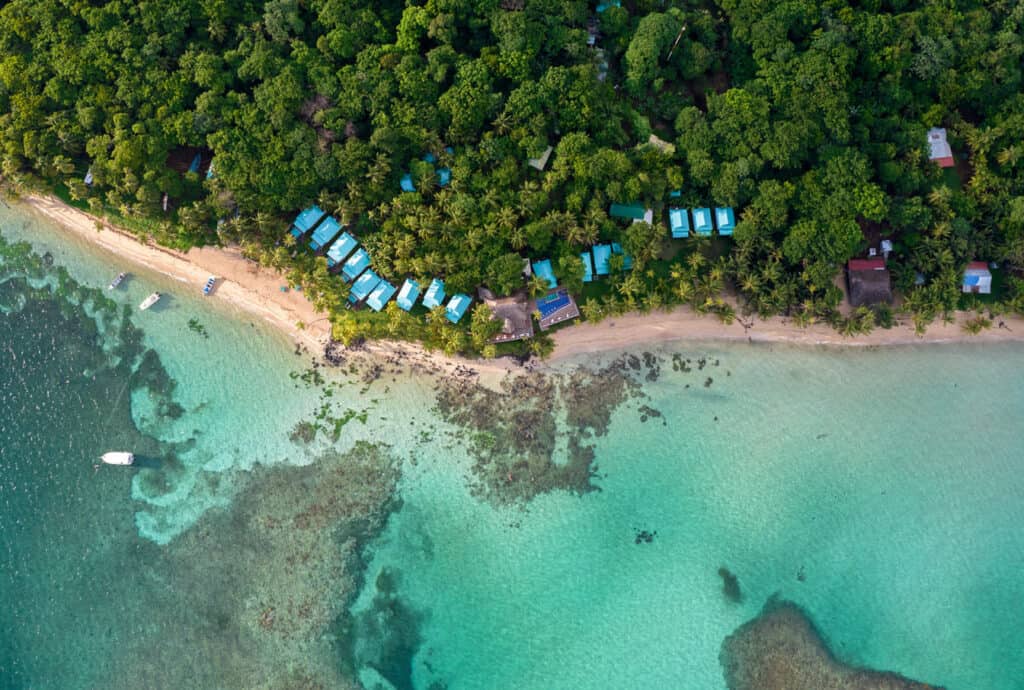
Travelers stay in oceanside casitas at Yemaya Reefs, the nicest accommodations on Little Corn Island. © Yemaya Reefs
What to Do on Little Corn Island
Despite its small size, Little Corn Island offers a rich mix of adventure, relaxation, and cultural immersion. Here are some of the top experiences not to miss:
Take a Guided Snorkeling Trip
For those looking to snorkel, the waters surrounding the island, especially off the northern and eastern coasts, are dotted with coral patches and healthy seagrass beds. Though some reefs require a boat to get to, those just offshore from Yemaya Reefs and along Otto Beach offer direct, walk-in access to these marine ecosystems, often with sightings of eagle rays, nurse sharks, and sea turtles.
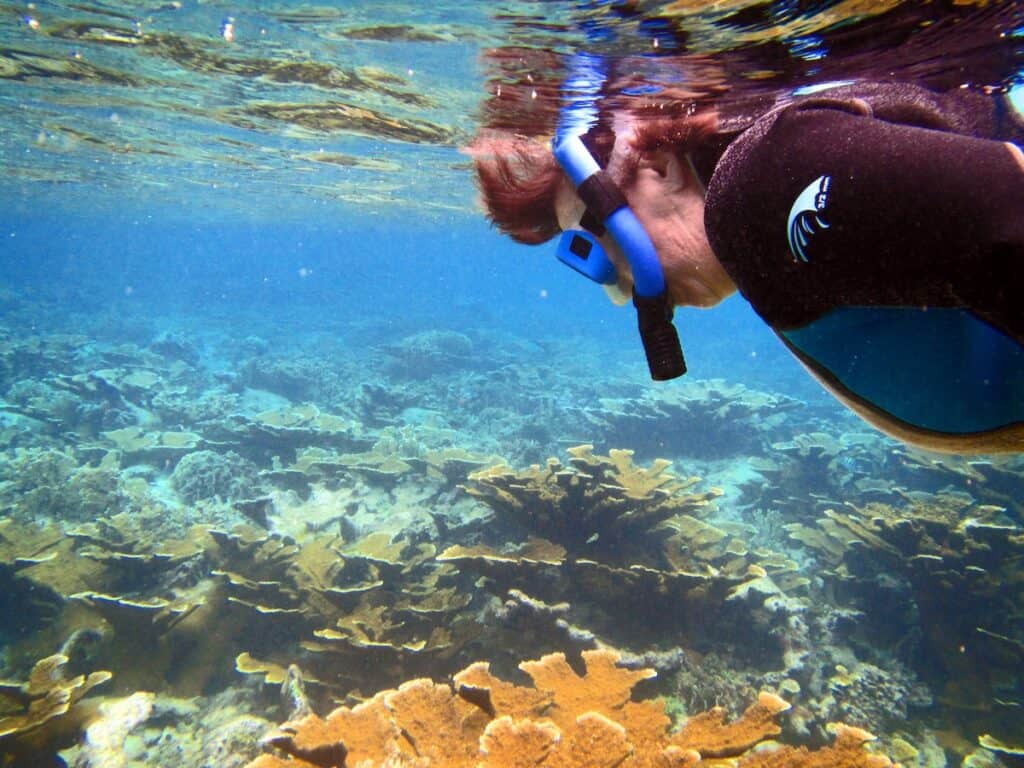
A snorkeler explores the coral reef ecosystems surrounding Little Corn Island, Nicaragua—home to some of the Caribbean’s most well-preserved marine life.
To fully experience the richness of these ecosystems, we recommend exploring them alongside a local naturalist guide. Our Nicaragua Snorkel & Volcano Adventure combines time on Little Corn Island with expert-led snorkeling excursions to some of the region’s most vibrant and biologically important reefs. Traveling with a knowledgeable guide not only helps you spot elusive species but also deepens your understanding of reef ecology, marine conservation, and the cultural history of the region
View Nicaragua Snorkeling Itinerary
Oceanic Society naturalist guide, Ernesto Ocampo, recalls his first snorkeling experience vividly: “Seeing the explosion of color and marine life below me felt like stepping into a living dream. It opened up a whole new world that I’ve been exploring and learning about ever since.” Today, he hopes to guide others toward that same unforgettable experience and deeper connection with the ocean.
Earn Your Open Water Diving Certification
Little Corn Island boasts approximately 20 dive sites within close proximity, plus the renowned Blowing Rock, a pinnacle dive site located 16 miles offshore known for its marine biodiversity and dramatic underwater formations.
For those interested in learning to dive, several locally run dive shops, like Dolphin Dive, offer PADI Open Water certification and daily excursions to outer reefs and cleaning stations. Cleaning stations are fascinating ecosystems where rays gather to have parasites removed by smaller fish, offering divers a front-row seat to one of nature’s most unique underwater interactions.
Fish, Paddle, & Explore the Coastline
For those seeking even more activity, rent a paddleboard or kayak (often available through the accommodation) and explore the calm bays. Early morning outings often reward paddlers with mirror-flat water.
Fishing has deep cultural roots on Little Corn Island, and there are opportunities for travelers to enjoy guided fly fishing on the flats (targeting bonefish, permit, or tarpon) or embark with a local captain for a hand-line or trolling trip offshore. You might return with a catch of yellowtail or mahi mahi. Some guesthouses will happily cook your catch, like The Lighthouse Retreat, turning your outing into a fresh, sustainably caught, ocean-to-table dinner.
Hike the Island Trails
With no roads or cars, the trails here are sandy footpaths that weave through groves of fruit trees and over gentle hills, and are great if you feel like exploring the lush forests and wetlands that cover the island. You can hike across the entire island in under two hours, or climb up to the old light shower tower (near The Lighthouse Retreat) for a great view of the island.
Relax with Yoga or Massage
Back on land, enjoying the slow pace of life is part of the experience. Treat yourself to a massage or take part in a beachfront yoga class offered by local eco-lodges. Or, simply spend the day lounging on a quiet stretch of sand with a good book at one of the island’s best beaches.
Snorkeling and Reef Conditions
Little Corn Island stands out as one of the Caribbean’s best-kept secrets, thanks to its relatively untouched coral reefs and low visitor numbers. Unlike in heavily developed tourist hotspots, the island’s marine ecosystems have remained mostly healthy, offering snorkelers the opportunity to witness inspiring underwater life in a setting that feels almost timeless.
Whether exploring shallow reefs right off the beach or venturing out on guided boat tours, you’ll encounter coral patches, schools of reef fish, and other curious marine creatures like rays and turtles. The island’s compact size and variety of nearby reefs make it easy to explore top sites without the hassle of long travel or decision fatigue.
Coral reefs worldwide face challenges from warming oceans and human impact, and those surrounding Little Corn are no exception. Some areas show signs of bleaching, highlighting the importance of responsible snorkeling practices. To help preserve these fragile ecosystems, avoid touching coral, wear sun-protective clothing, and choose reef-safe sunscreen made from natural minerals. Always follow your guide’s advice to minimize disturbance to marine life and help keep these reefs vibrant for generations to come.
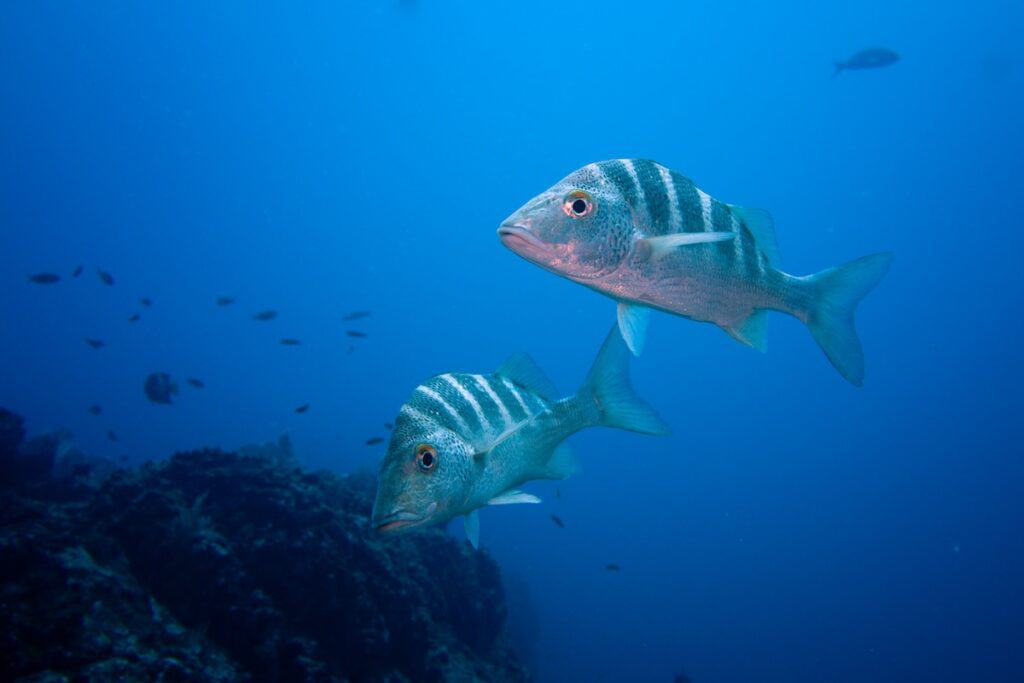
© Juanma Clemente Alloza
Top Beach-Accessible Snorkeling Spots:
- Otto Beach: Right in front of Yemaya Reefs hotel, this reef is perfect for easy access and teeming with marine life.
- Blue House Rocks: A few minutes’ walk northeast of Otto Beach, known for its coral heads and schools of reef fish.
- Iguana Reef: On the island’s southeastern side—worth the walk for its clear water and biodiversity.
- Dolphin Shallows: Near the main town, this calm western reef is ideal for beginners and night snorkeling, when creatures like seahorses emerge.
Boat-Accessible Reefs (Guided Tours):
- White Holes: A sandy-bottom spot where nurse sharks often rest during the day.
- Little Corn Reef: A vibrant offshore reef typically included in full-day guided trips.
Marine Life and Animals You Might See
The lush wilderness above and below the water is what makes Little Corn Island an iconic ecotourism destination, and with that comes a diverse cast of wildlife you may be lucky enough to see.
Underwater Wildlife
- Brightly-colored parrotfish, wrasses, damselfish, and angelfish dart through coral reefs in dazzling colors.
- Stingrays rest on sandy bottoms, camouflaged against the sea floor.
- Spotted eagle rays glide over coral gardens and can be identified by their beautiful dotted-patterned wings
- Nurse sharks (which can grow up to 10 feet long), gentle and curious, often nap in shallow reefs like White Holes.
- Hawksbill sea turtles, an endangered species, are known to nest on the island and may be found on its reefs.
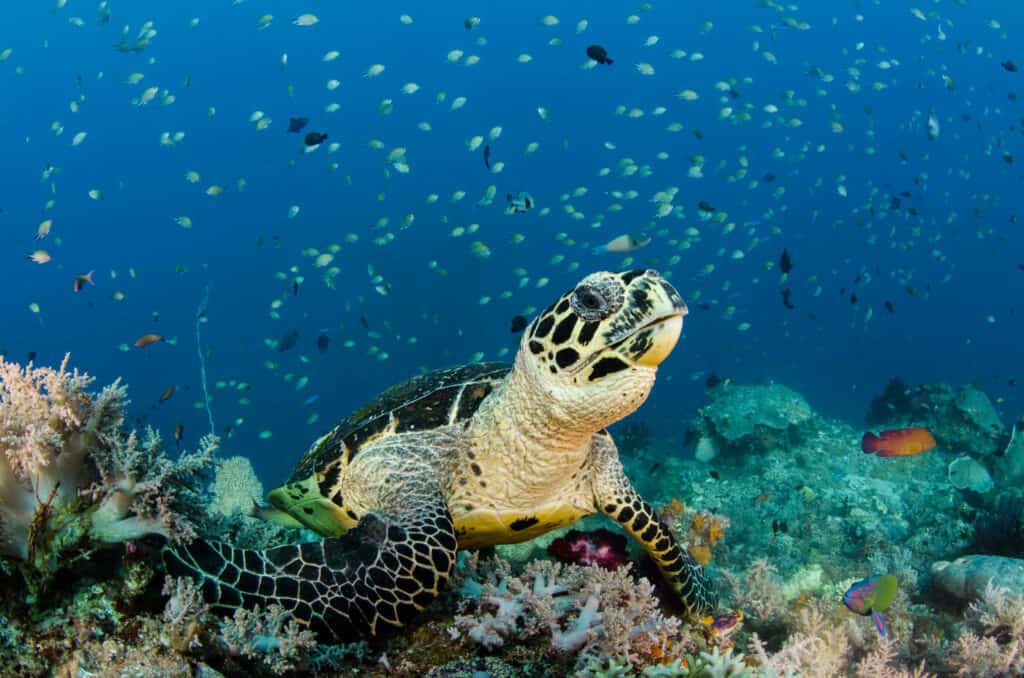
Hawksbill sea turtles can be found on the reefs around Little Corn, an iconic sight in a healthy marine ecosystem. © Pete Oxford
Terrestrial Wildlife
- The Little Corn Island frog, a critically endangered species found nowhere else, can be seen in the jungles of the island. Keep an eye out for a tiny dark brown or olive green frog at dusk and dawn, especially after rainfall.
- Large green iguanas, which grow up to six feet long, can be spotted basking in the midday sun.
- Magnificent Frigatebirds, with iconic toad-like gullets, let out guttural calls during courtship.
- Brown Pelicans can often be seen diving and fishing along the coastal waters.
- White-crowned Pigeons nest amongst the groves of mangroves, and sometimes commute more than 30 miles daily.
- Osprey will perch along the coast and scan the coastal waters for fish.
- Little Blue Herons, with vibrant blue and maroon coloring, wade through shallow waters.
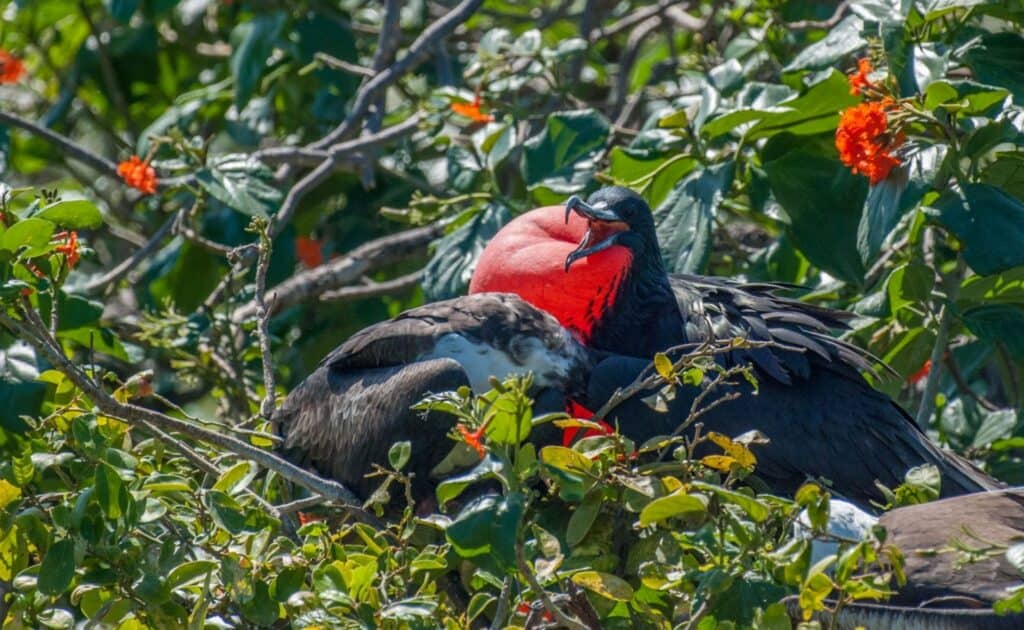
Frigatebirds gather in coastal vegetation when not soaring high above, an iconic sight on tropical islands like those near Little Corn.
Ethical Wildlife Encounters
As a visitor, one of the best ways to ensure this natural wealth endures is by choosing eco-conscious tour operators. Many snorkeling and diving businesses on Little Corn are run by locals deeply committed to sustainability—guides who educate visitors on reef etiquette, use mooring buoys instead of anchors, and keep group sizes small to minimize impact.
At Oceanic Society, we’re proud to practice these principles in every expedition we lead. By prioritizing responsible tourism, we help safeguard coral reefs and marine life while supporting the island’s economy. Ecotourism provides residents with income that depends on preserving their natural resources rather than exploiting them. Tour guide Ernesto Ocampo has witnessed this transformation firsthand: “Eco-tourism raises awareness about the importance of protecting ecosystems. It gives value to forests, rivers, and wildlife beyond extraction or destruction. When travelers come to experience a cloud forest or paddle through mangroves, they’re not just observing—they’re helping fund conservation efforts and reinforcing that these places matter.”
Is Little Corn Island Worth Visiting?
Absolutely, especially for nature lovers looking to unplug. Little Corn is perfect if you’re looking to escape modern distractions, avoid crowds, and find a peaceful corner of the Caribbean far from noisy resorts and nightlife.
Imagine waking to the sound of tropical birds, sipping coffee on your porch, and wandering barefoot across the island beneath mango trees. Snorkel straight from the shore into coral gardens alive with reef fish, sea turtles, and maybe even a passing pod of dolphins. Then cap off your day with fresh seafood at a family-run restaurant and a sunset cocktail on the beach.
This is just a glimpse of what awaits at Little Corn Island. If any of those scenarios speak to you, then yes, Little Corn Island is definitely worth visiting!
For those eager to experience Little Corn Island alongside expert naturalists like Ernesto, Oceanic Society’s Nicaragua Snorkel & Volcano Adventure offers a guided exploration of the island’s vibrant coral reefs and natural beauty, paired with visits to Granada’s colonial landmarks, cloud forests, and the active Masaya Volcano.
👉 Explore upcoming departures, and sign up for our newsletter to receive expedition updates, travel inspiration, and ocean conservation insights delivered straight to your inbox.

